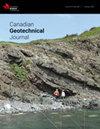Iron ore tailings stabilization with alternative alkali-activated cement for dry stacking: mechanical and microstructural insights
IF 3.5
3区 工程技术
Q2 ENGINEERING, GEOLOGICAL
引用次数: 0
Abstract
Canadian Geotechnical Journal, Ahead of Print.Upstream tailings dams are high-risk structures that have experienced several failures worldwide, particularly with iron ore tailings (IOT). In this study, new disposal methods/techniques, such as cement-stabilized dry stacking, are discussed that provide enhanced mechanical behavior while reducing failure risks. Alkali-activated materials are used as cementing agents due to their mechanical and environmental advantages compared to ordinary Portland cement. This study evaluates the mechanical and microstructural behavior of IOT stabilized with an alkali-activated cement (AAC) composed of two by-products from the IOT beneficiation process, metakaolin and sodium silicate, tested under plane strain conditions. Simple shear tests and microstructural analysis were performed. Mixtures of IOT were produced with 0%, 1%, 3%, and 5% AAC to examine the influence of such variables on strength and deformability parameters under undrained conditions. The mixtures with 3% and 5% AAC showed the greatest impact on the strength; however, the addition of 1% AAC was able to reduce positive pore-pressure generation. Cementitious bounds were evidenced by forming a sodium aluminosilicate hydrate gel. The studied AAC was effective in stabilizing IOT, even at small contents.
使用替代碱活性水泥稳定铁矿尾矿以进行干堆放:机械和微观结构分析
加拿大岩土工程学报》,印刷前。 上游尾矿坝是一种高风险结构,在全球范围内曾多次发生溃坝事故,尤其是铁矿石尾矿 (IOT)。本研究讨论了水泥稳定干堆放等新的处置方法/技术,这些方法/技术可增强机械性能,同时降低溃坝风险。与普通硅酸盐水泥相比,碱活性材料具有机械和环境优势,因此被用作胶结剂。本研究评估了使用碱活性水泥(AAC)稳定 IOT 的机械和微观结构行为,AAC 由 IOT 选矿过程中产生的两种副产品偏高岭土和硅酸钠组成,并在平面应变条件下进行了测试。进行了简单的剪切试验和微观结构分析。在 IOT 混合物中分别添加了 0%、1%、3% 和 5%的 AAC,以考察这些变量在排水条件下对强度和变形性参数的影响。含 3% 和 5% AAC 的混合物对强度的影响最大;然而,添加 1% AAC 能够减少正孔隙压力的产生。通过形成水合硅酸铝钠凝胶,证明了水泥基界。所研究的铝酸钙能有效稳定 IOT,即使含量较低也是如此。
本文章由计算机程序翻译,如有差异,请以英文原文为准。
求助全文
约1分钟内获得全文
求助全文
来源期刊

Canadian Geotechnical Journal
地学-地球科学综合
CiteScore
7.20
自引率
5.60%
发文量
163
审稿时长
7.5 months
期刊介绍:
The Canadian Geotechnical Journal features articles, notes, reviews, and discussions related to new developments in geotechnical and geoenvironmental engineering, and applied sciences. The topics of papers written by researchers and engineers/scientists active in industry include soil and rock mechanics, material properties and fundamental behaviour, site characterization, foundations, excavations, tunnels, dams and embankments, slopes, landslides, geological and rock engineering, ground improvement, hydrogeology and contaminant hydrogeology, geochemistry, waste management, geosynthetics, offshore engineering, ice, frozen ground and northern engineering, risk and reliability applications, and physical and numerical modelling.
Contributions that have practical relevance are preferred, including case records. Purely theoretical contributions are not generally published unless they are on a topic of special interest (like unsaturated soil mechanics or cold regions geotechnics) or they have direct practical value.
 求助内容:
求助内容: 应助结果提醒方式:
应助结果提醒方式:


